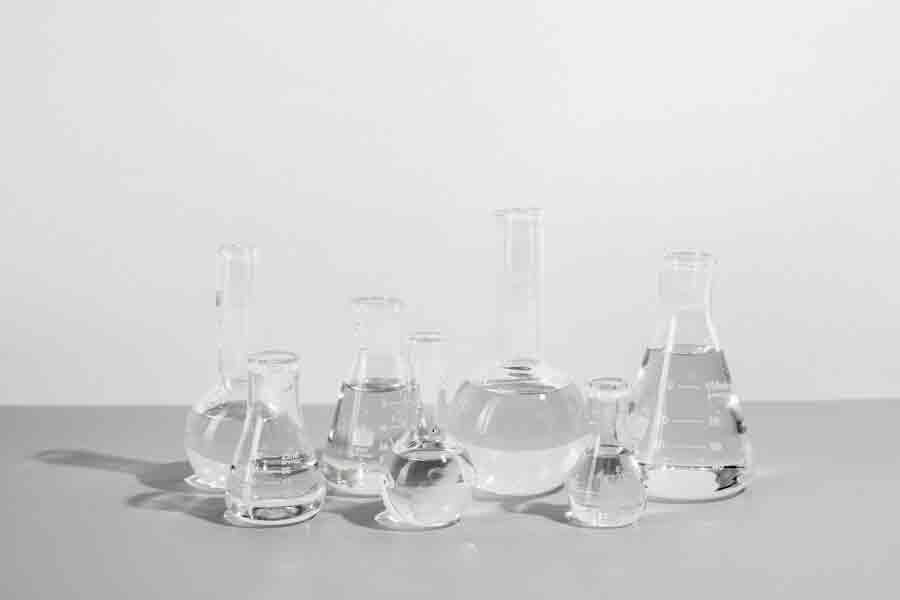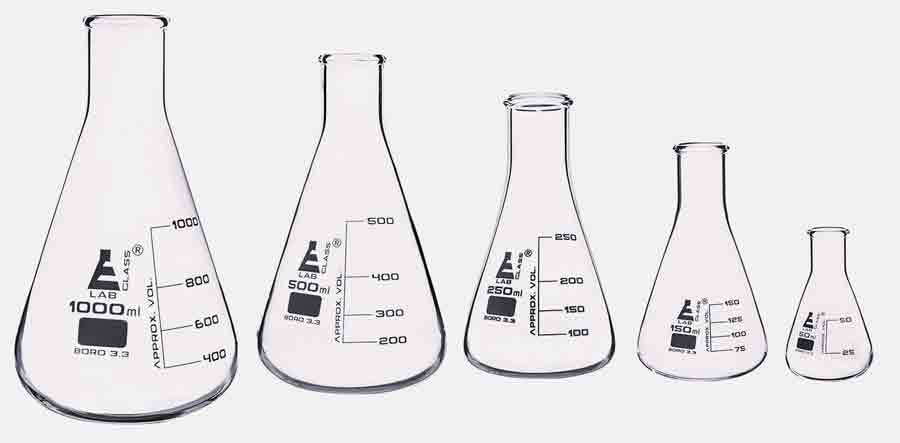Table of Contents
Introduction:
Erlenmeyer flask Sizes are the workhorses of the laboratory, essential for a wide range of experiments and chemical procedures.
Their iconic conical shape with a narrow neck and wide base makes them versatile tools for mixing, heating, reacting, and storing liquids. In this comprehensive guide, we’ll explore the different Erlenmeyer flask sizes and types and their uses in various laboratory settings.
range of sizes to accommodate different volumes of liquids. The sizes typically vary from small to large, with capacities ranging from a few milliliters to several liters.

Erlenmeyer flask sizes
1. 25-mL flask
2. 50-mL flask
3. 100-mL flask
4. 250-mL flask
5. 500-mL flask
6. 1 L (1000 mL) flask
7. 2 L flask
8. 5 L flask
1. 25-mL Erlenmeyer Flask: A Miniature Miracle
Erlenmeyer Flask sizes in The 25-mL may be small, but it packs a punch when it comes to versatility and utility in the lab. Take a closer look at this miniature wonder here:
Size and capacity:
The 25-ml Erlenmeyer flask is one of the smallest standard Erlenmeyer flask sizes available. Its compact design makes it perfect for experiments that require only small amounts of fluid. Despite its small size, this flask is capable of holding enough liquid for a variety of uses.
Multifaceted talent:
Don’t let its small size fool you; the 25-ml Erlenmeyer Flask is incredibly versatile. It is commonly used in academic and research laboratories for a wide range of purposes. From small-scale reactions and titrations to storage and sample preparation, this flask can handle it all.
accuracy:
When precision is important, the 25-ml Erlenmeyer flask delivers. Its small size makes it ideal for experiments requiring precise measurements and precise control over reactant concentrations. Whether you’re sequencing reactions on a small scale or preparing solutions with precise specifications, this flask ensures that every drop counts.
Space Saving:
In crowded laboratory settings where bench space is at a premium, the compact size of the 25-ml Erlenmeyer flask is a major advantage. Its small footprint allows you to maximize space efficiency without compromising functionality. This is especially useful in teaching laboratories, where many experiments are conducted simultaneously.
Special attention:
Although the 25-mL Erlenmeyer flask offers many advantages, it should be noted that its small size may present challenges in some situations. For example, its narrow neck makes it difficult to accurately add or withdraw liquids, especially when using a pipet or burette. Additionally, care must be taken to ensure proper mixing and reaction kinetics at such a small scale.
conclusion:
The 25-ml Erlenmeyer flask may be small, but it’s mighty in terms of versatility, precision, and space-saving capabilities. Whether you’re conducting small-scale experiments, preparing solutions, or teaching the next generation of scientists, this miniature marvel will be a valuable addition to your laboratory toolkit.
2. 50-ml Erlenmeyer Flask:
The smallest of the group, the 50-mL Erlenmeyer flask, is ideal for small-scale experiments, titrations, and reactions where accuracy and economy of space are important. It is commonly found in teaching laboratories and introductory chemistry courses.
3. 100-ml Erlenmeyer Flask:
Slightly larger than its 50-mL counterpart, the 100-mL flask offers somewhat more volume while maintaining versatility and ease of operation. It is ideal for small-scale reactions and experiments in academic and research settings.
4. 250-ml Erlenmeyer flask:
The 250-ml flask strikes a balance between volume and practicality. It is commonly used in academic and research laboratories for a variety of applications, including mixing, heating, and storing liquids.
5. 500-ml Erlenmeyer Flask:
A large-capacity, 500-mL Erlenmeyer flask is ideal for large-scale experiments and reactions. It is commonly used to grow microorganisms, prepare solutions, and conduct chemical reactions on a small scale.
6. 1000 ml (1 L) Erlenmeyer Flask:
The largest standard volume, the 1000-mL Erlenmeyer flask, is ideal for large-scale experiments, mixing large amounts of liquids, and preparing large-scale solutions. It is commonly found in industry and research laboratories.
7. 2L Erlenmeyer Flask:
Size and Capacity: The 2L Erlenmeyer flask offers a medium capacity suitable for medium-scale experiments and reactions.
Versatile: It is commonly used in research and industrial laboratories to grow microorganisms, prepare large-scale solutions, and conduct chemical reactions.
Convenience: With its large size, the 2L flask reduces the need for frequent filling and allows efficient handling of large quantities of liquids.
Category and Types:
1. Conventional Erlenmeyer flask:
Standard Erlenmeyer flask sizes are made of borosilicate glass and are suitable for most general laboratory applications. It is designed to mix chemicals, heat them, and react.
2. Volumetric Erlenmeyer flask:
Volumetric flasks are used to make accurate measurements and to prepare solutions of known concentrations that are calibrated to hold a specific volume at a specific temperature.
3. Erlenmeyer flask filtration:
Fitted with sides fitted with hose barbs, filtration Erlenmeyer flask sizes allow vacuum filtration of liquids. They are necessary to separate solids from liquids by filtration.
4. Boiling Erlenmeyer flask:
Designed to withstand direct heat and boiling liquids, boiling flasks have thicker walls than regular Erlenmeyer flask sizes. They are suitable for heating applications on a Bunsen burner or hot plate.
5. Reaction Erlenmeyer flask:
Designed specifically for chemical reactions that may produce gas or foam, reaction Erlenmeyer flask sizes have a wide base and a more pronounced neck to prevent splashing or overflow during the reaction
Conclusion:
Choosing the right Erlenmeyer flask sizes is important to ensure accurate measurements and efficient experiments in the laboratory. By considering factors such as volume of solution, desired accuracy, and workplace space constraints, scientists can make informed decisions about what size flask to use.
Whether it’s a small-scale experiment that requires precise measurements or a large-scale manufacturing process that requires high volumes, there is an Erlenmeyer flask size to suit every need.
By understanding the importance of flask sizes and their impact on experimental outcomes, researchers can improve their workflow and contribute to advances in science and technology.”

